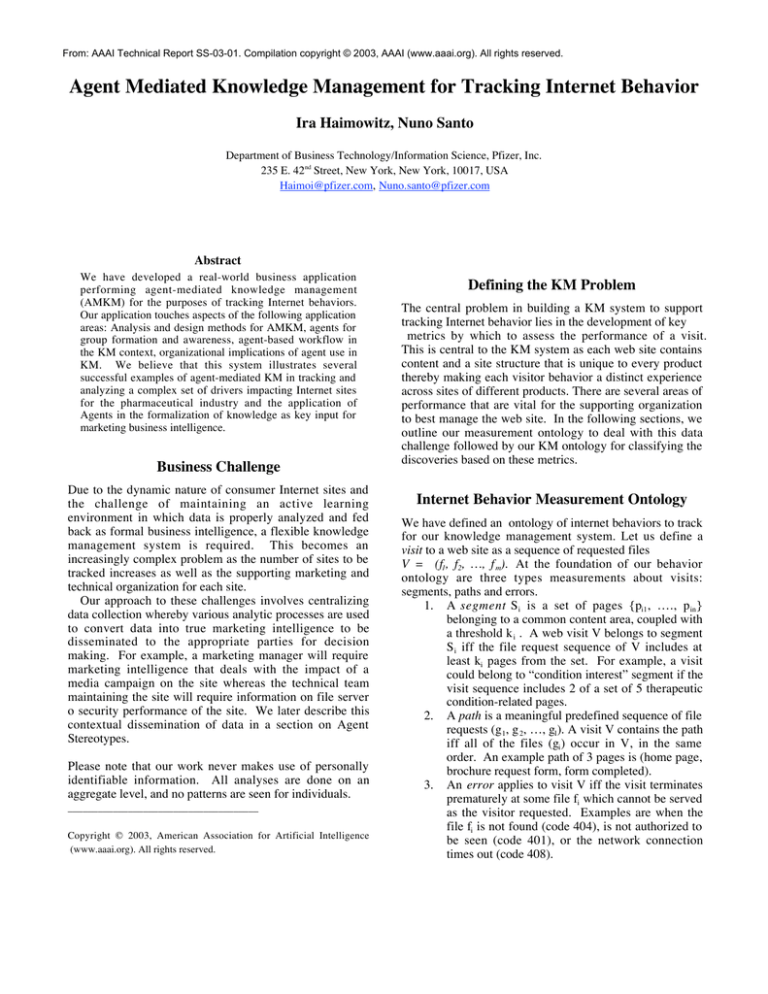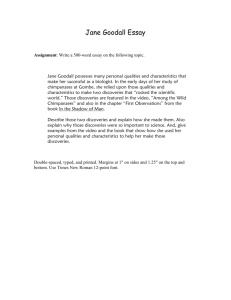
From: AAAI Technical Report SS-03-01. Compilation copyright © 2003, AAAI (www.aaai.org). All rights reserved.
Agent Mediated Knowledge Management for Tracking Internet Behavior
Ira Haimowitz, Nuno Santo
Department of Business Technology/Information Science, Pfizer, Inc.
235 E. 42nd Street, New York, New York, 10017, USA
Haimoi@pfizer.com, Nuno.santo@pfizer.com
Abstract
We have developed a real-world business application
performing agent-mediated knowledge management
(AMKM) for the purposes of tracking Internet behaviors.
Our application touches aspects of the following application
areas: Analysis and design methods for AMKM, agents for
group formation and awareness, agent-based workflow in
the KM context, organizational implications of agent use in
KM. We believe that this system illustrates several
successful examples of agent-mediated KM in tracking and
analyzing a complex set of drivers impacting Internet sites
for the pharmaceutical industry and the application of
Agents in the formalization of knowledge as key input for
marketing business intelligence.
Business Challenge
Due to the dynamic nature of consumer Internet sites and
the challenge of maintaining an active learning
environment in which data is properly analyzed and fed
back as formal business intelligence, a flexible knowledge
management system is required. This becomes an
increasingly complex problem as the number of sites to be
tracked increases as well as the supporting marketing and
technical organization for each site.
Our approach to these challenges involves centralizing
data collection whereby various analytic processes are used
to convert data into true marketing intelligence to be
disseminated to the appropriate parties for decision
making. For example, a marketing manager will require
marketing intelligence that deals with the impact of a
media campaign on the site whereas the technical team
maintaining the site will require information on file server
o security performance of the site. We later describe this
contextual dissemination of data in a section on Agent
Stereotypes.
Please note that our work never makes use of personally
identifiable information. All analyses are done on an
aggregate level, and no patterns are seen for individuals.
______________________________________
Copyright © 2003, American Association for Artificial Intelligence
(www.aaai.org). All rights reserved.
Defining the KM Problem
The central problem in building a KM system to support
tracking Internet behavior lies in the development of key
metrics by which to assess the performance of a visit.
This is central to the KM system as each web site contains
content and a site structure that is unique to every product
thereby making each visitor behavior a distinct experience
across sites of different products. There are several areas of
performance that are vital for the supporting organization
to best manage the web site. In the following sections, we
outline our measurement ontology to deal with this data
challenge followed by our KM ontology for classifying the
discoveries based on these metrics.
Internet Behavior Measurement Ontology
We have defined an ontology of internet behaviors to track
for our knowledge management system. Let us define a
visit to a web site as a sequence of requested files
V = (f1, f2, …, f m). At the foundation of our behavior
ontology are three types measurements about visits:
segments, paths and errors.
1. A segment S i is a set of pages {pi1 , …., p in }
belonging to a common content area, coupled with
a threshold k i . A web visit V belongs to segment
S i iff the file request sequence of V includes at
least ki pages from the set. For example, a visit
could belong to “condition interest” segment if the
visit sequence includes 2 of a set of 5 therapeutic
condition-related pages.
2. A path is a meaningful predefined sequence of file
requests (g1, g 2, …, gl ). A visit V contains the path
iff all of the files (gi ) occur in V, in the same
order. An example path of 3 pages is (home page,
brochure request form, form completed).
3. An error applies to visit V iff the visit terminates
prematurely at some file fi which cannot be served
as the visitor requested. Examples are when the
file fi is not found (code 404), is not authorized to
be seen (code 401), or the network connection
times out (code 408).
We regularly track the percentage of visits on each web site
that belong to segments or contain paths. We also track the
absolute count of visits having errors. These percentages
and counts are monitored using statistical process control
(SPC) [Wheeler et. al 1992]. The time period in our SPC
charts is most often daily for errors, and weekly for
segments and paths. When a percentage is beyond the
upper or lower control limits set by time-series forecasting,
an alert is automatically sent to agents via e-mail.1
Agent Stereotypes
We encode our agents using stereotypes based on web site
and job function. Thus the marketing stereotype agent for
a given web site will receive e-mails about exceptional
changes for segments and paths. The technical stereotype
agent for that web site will receive emails about
exceptional errors. Different agents may represent a
person, if that person is cross-functional.
Tailoring communications using stereotypes is a decades
old natural language technique, attributed to [Rich 1979].
It would be only a modest enhancement to allow people to
build their own individualized agents picking and choosing
what alerts they should be emailed. This would yield a
more realistic mix [Sparck-Jones 1987] .
Tracking System Status and Example
Our automated tracking and e-mail alerting system has
been implemented, serving over thirty users while tracking
over ten product-related patient education as well as
corporate Internet sites.
The web logs are analyzed daily using a leading
commercial software tool. SAS IntelliVisor for Pharma
[SAS 1991] is an Application Service Provider (ASP)
solution that provides e-channel analysis to improve
campaign strategies, marketing programs, and consumer
understanding, which facilitates improvement in brand
awareness activities.
Figure 1. Example e-mail alert send to “technical” agents for
a given web site.
Above is an actual emailed alert to technical agents when a
particular web site had an unusually high number of “Error
404 – File not Found” errors based on the time series
forecast for the previous day. The email contains a hotlink to a web site hosted on SAS Intellivisor. A person
receiving the email and clicking on the link goes to a
technical agent alert summary page displayed in Figure 2.
Figure 2. Technical agent alert summary page.
In this page a user can see an SPC profile for each
technical metric on that alerted day. Listed are the metric,
the actual value, the predicted value, and the lower and
upper control limits. Clicking on a particular metric
displays the process control chart illustrating the recent
exceptionally high (or low) value. The chart appears below
in Figure 3, demonstrating an unusually high recent value.
Exceptional traffic-related alerts are sent daily to technical
agents for their specific web sites. Exceptional business
segment, pathing, and referral alerts are sent to marketing
agents on a weekly basis.
Figure 3. Statistical process control chart demonstrating
latest days unexpectedly high “404 File not Found” errors.
1
We also run similar alerts on more
traditional web traffic measures like total
visits, average visit time, etc.
A person reviewing this data decides whether or not to
view other web log related analyses, to contact a colleague,
or to take direct action. If the situation has ultimately led
to a web site improvement or other business benefit, the
user can submit an entry to the knowledge management
system we have described earlier.
Organizational Interaction with KM System
In the current stage of our KM system as illustrated below
in figure 4 and figure 5, we are manually inputting the
discoveries of our agents that impact a decision related to
managing the website both from a marketing and technical
standpoint. In today’s environment, we work closely with
the marketing and technical teams and track which
discoveries led to which decision in addition to projecting
an economic benefit as a result of this new decision. To
deal with the diversity of possible decisions and actions,
we have developed a KM ontology that classifies decisions
along several dimensions. They range from technical
decisions such as improving the overall navigation of the
site to which on-line campaign performed the best.
Brand X
Disease X
Brand X
Disease
X
Brand Y
Brand Z
Disease
X
Figure 5. A sample report from our KM system listing the
impact of agent findings.
Future Directions
Our agent-mediated knowledge management system has
had great business impact, but could be made more
automated to reduce the time delays and omissions inherent
in of manual review of e-mailed alerts. We also would like
agents to make automatic entries into the KM knowledge
base. One route would be to make the agents more
intelligent and program them to interact with each other,
much like the buyer and seller agents of automated
auctions as in [Jain et, al. 1999]. We can also reduce the
number of alerts and yield a higher true-positive rate by
using multivariate trend templates [Haimowitz and
Kohame 1993].In addition, we plan to data mine the KM
knowledge base to understand what web site attributes and
alert types combine for biggest business benefit.
References
Figure 4. Example of our KM system data entry screen using
our KM Ontology for inputting the impact of agent
discoveries.
Business Impact
As we are actively tracking the decisions made as a result
of our agent discoveries, we are able to collectively share
these discoveries with our Internet management
organization at large. We have developed a series of
reports (see sample report in figure 5) that aggregate these
discoveries and the decisions made across all the products
sites as well as by the type of decision. These reports are
shared with both the technical and marketing organization
based on their stereotype. We have to date collected over
50 discoveries which have led to a range of significant
decisions from an entire re-design of a web site, adding or
removing content, to re-allocating the budget for various
on-line media campaigns.
Haimowitz, I., Isaac, K. (1993), An Epistemology for
Clinically Significant Trends
Jain, A.K., Aparicio, M., and Singh, M.P. (1999), Agents
for Process Coherence in Virtual Enterprises,
Communications of the ACM, vol. 42, no. 3, March 1999,
pp. 62-69.
Rich, E. (1979), User Modeling via Stereotypes, Cogitive
Science, vol 3, pp. 329-354.
SAS Institute Inc.(2001), SAS IntelliVisor for
Pharma(SM),
http://www.sas.com/solutions/intellivisor/pharma.html
Sparck-Jones, K. (1987) Realism About User Modeling,
University of Cambridge Computer Laboratory Technical
Report No. 111.
Wheeler, D. J., Chambers, D.S., Edwards, W. (1992),
Understanding Statistical Process Control, SPC Press.




